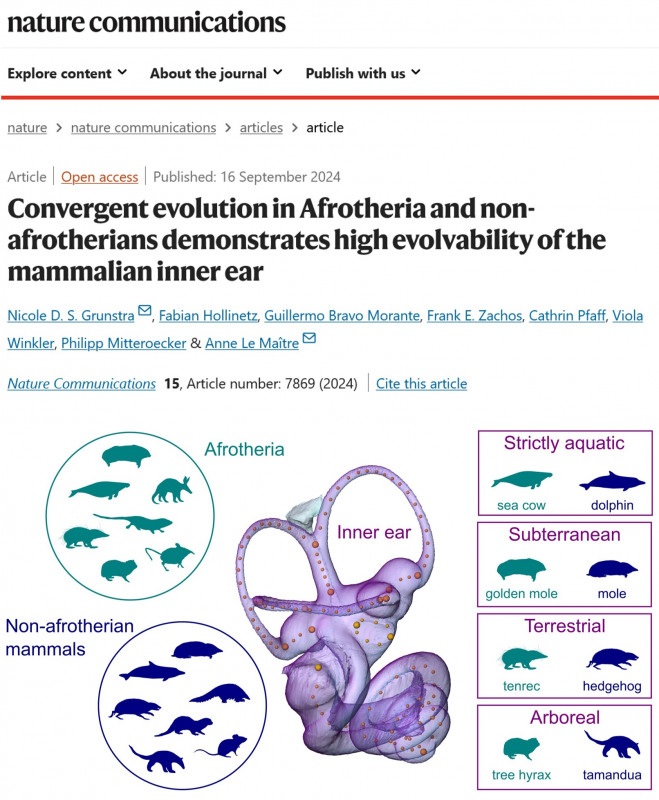News Details

A recent paper in Nature Communications, co-led by Nicole Gunstra (University of Vienna), Anne Le Maître (KLI) and Philipp Mitteröcker (KLI and University of Vienna) reveals convergent evolution of the inner ear in Afrotherian and non-Afrotherian mammals who have similar ecologies, demonstrating its high evolvability.
The vertebrate ear not only allows hearing, but also plays a crucial role in balance, posture and gaze stabilization. Some of the most remarkable evolutionary changes in the vertebrate ear is observed in mammals, wherein various parts of the jaw bones have been modified and integrated to become part of the middle ear (unlike in birds and reptiles where they remain part of the jaw). These modifications allow mammals a much wider bandwidth of hearing, especially high tones. The inner ear in mammals also displays a vast diversity, especially in the length and curvature of the cochlea, unlike what is observed in other tetrapods. The mammalian inner ear, comprising two functional parts ‘encapsulated within the densest bone of the skeleton’, reaches its adult size even before birth. The shape of the inner ear reflects evolutionary lineage wherein closely related species have more similar inner ear structures than distantly related ones, and therefore share traits that could be neutral or non-adaptive. However, other factors such as environment and modes of locomotion could lead to adaptive evolution in the shape and size of the inner ear. This implies that animals that are not closely related but inhabit similar habitats (e.g. aquatic), or have similar ecologies (e.g. foraging behavior) could have very similar inner ear features that help them thrive in their respective habitats.
A team of evolutionary biologists and palaeontologists from the University of Vienna, the KLI and the Natural History Museum of Vienna examined the inner ear morphology of 40 mammalian species from museum specimen, 20 species belonging to superorder Afrotheria, and another 20 belonging to non-afrotherian superorders. Afrotherian mammals have their evolutionary origins in Africa, and are more closely related to each other than to other superorders. Afrotherians included sea cow, elephant shrew, greater hedgehog tenrec, hyrax and golden mole. Non-afrotherians used in the study include dolphins, mouse deer, rabbits, European hedgehog, house mouse, and black rat. A comparative analysis of inner ears of Afrotheria and their non-Afrotheria analogues, based on morphology, habitat, behavioral ecologies etc. gave a startling result. Animals with very little genetic relatedness but inhabiting similar habitats or having similar ecologies, showed high similarity in their inner ears—a clear case of convergent adaptive evolution, demonstrating high evolvability of the inner ear in mammals! The authors explain that this high evolvability is facilitated by the anatomical, genetic and developmental complexity of the mammalian ear, which bestows upon it a higher developmental modularity, and consequently leading to the high diversity observed in ears of mammals as compared to other vertebrates.

